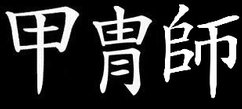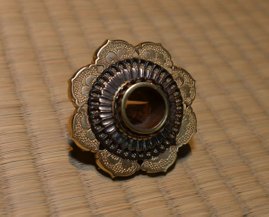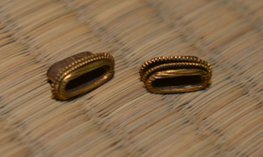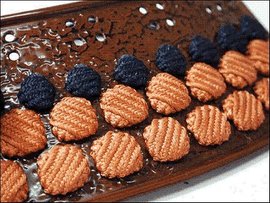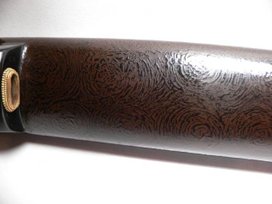For all enquiries...
Copyright Katchushi 2019 on all Text and Photographs
Katchushi Restoration
修復
The correct conservation/ restoration of fine Japanese armour requires a multitude of skills that have to be mastered separately before they are all brought together to achieve work of the highest standard. These include the craft of the Kaji 鍛冶 (Blacksmith), the Shirogane-shi 白金師 (Silversmith) and the Urushi-be 漆部 (lacquerer) to name just a few. Of course in the past, the creation of armour was achieved by many different craftsmen and craftswomen, all of whom were masters and specialists in their particular fields.
Today, however the professional Japanese conservator/ restorer usually works alone and has to utilise these many skills in their work. In recent years, other "restorers" of Japanese armour have materialised with bogus claims and skills, offering the finest restoration outside of Japan. Restoration of lacquer and silk lacing etc, although time-consuming, is a relatively simple process, done correctly of course. If the self proclaimed "Katchushi" cannot himself make the soft metal edging that adorns various components of an armour (known as Fukurin) from one piece of metal (not soldered!) or cannot reproduce or repair fine engraved Shakudo fittings, or have sufficient skill to reproduce, say, a complete missing part of an armour using exactly the same materials and processes as the original, they should be approached with extreme caution. Even more so if they use modern mass produced reproduction metal armour fittings and components. The use of these will seriously de-value any suit of historic Japanese armour, especially one of rarity, and important provenance. If in doubt ask to see accreditation and a qualification to show that they have undergone sufficient study and training to an international recognised standard to show that they have the competance and the necessary knowledge to work on historic works of art. Ask to see detailed photographs of their work, not photos taken at a distance.
These formal conservation/ restoration qualifications were developed for a reason, so as to ensure a continuing high level of knowledge and skill to the fine art world, whether it be collectors or dealers, museums or private institutions, to preserve our cultural heritage whatever that culture may be.
My professional occupation encompasses all manner of Japanese armour, sword fitings and Japanese fine art conservation and restoration.. Some examples and details of which are given below.
The unique soft doeskin leathers stencilled in a wide variety of patterns and used to cover various parts on Japanese armour. Using genuine Japanese doeskin, all traditional patterns are available to restore an armour or if a specific design is required I will hand cut a stencil, using traditional persimmon tannin coated ‘Katagami 型紙’ paper. Traditionally smoked doeskin leather (Fusubegawa 燻る革 ) made by a master in Japan is also available.
The numerous ornamental gilt copper 金銅 (and Shakudo 赤銅) metal fittings found adorning armour. I make these by hand to order and are of the highest quality (absolutely no stampings, castings or machine made copies). Any design or style can be made including fittings made from genuine classic Shakudo 赤銅.
All parts of the Japanese sword can be handmade to your exact requirements, including Habaki 鎺, Seppa 切羽, Shitadome etc. Soft metal fittings (copper 赤金, sentoku 宣徳 (brass), Shakudo 赤銅, Shibuichi 四分一 etc) that have lost their original patina, can be restored to their original condition using the same traditional colouring techniques used by the ‘Iroage-shi’ (metal colouring craftsman). Thereby restoring the collectability and value of items such as Tsuba 鍔, Fuchi 縁, Kashira 頭, Kozuka 小柄 and Menuki 目貫. Russet iron, as found on good Tsuba 鍔 has the look of being 'Shibumi 渋み' (understated elegance), which is highly admired by collectors. This can also be restored. Lost inlays, in Hira-zogan (flat inlay) or Taka-zogan (raised) on all Kodogu can also be made and replaced.
Re-lacing parts of or a whole suit of armour in either Shikagawa odoshi 鹿革威 (doeskin leather) or Odoshi ito 威糸 (pure silk braid). A match and weave service is also available to match an original silk braid to the area to be repaired. Authentic Japanese plant and vegetable dyes can also be used to create the same historic colours as used in the past.
Repairs to damaged original Urushi lacquer or the complete re-lacquering of the saya (scabbard) of the Japanese sword. Using only genuine natural Urushi 漆, I can restore or replicate a wide variety of finishes including ‘Kuro-iro 黒蠟色’ (Highest quality polished black lacquer), ‘Shu 朱漆’ (Highest quality cinnabar lacquer), ‘Ishime 石目’ (Stone ground), ‘Kinnashiji 金梨地’ (Gold pearskin), ‘Tate-kin-nuri 立金塗' (Irregular gold lacquer) to name just a few.
Japanese armour restorer
Japanese armour restorer
Japanese armour restorer
Japanese armour restorer
Japanese armour restorer
Japanese armour restorer
Japanese armour restorer
Japanese armour restorer
Japanese armour restorer
Japanese armour restorer
Japanese armour restorer
Japanese armour restorer
Japanese armour restorer
Japanese armour restorer
Samurai armour restoration
Samurai armour restoration
Samurai armour restoration
Samurai armour restoration
Samurai armour restoration
Katchushi UK
Katchushi UK
Katchushi UK
Katchushi UK
Katchushi UK
Katchushi UK
Katchushi Studio
Katchushi Studio
Katchushi Studio
Katchushi Studio
Katchushi Studio
Katchushi Studio
Katchushi Studio
Katchushi Studio
Katchushi Studio
Japanese Armor Restorer
Japanese Armor Restorer
Japanese Armor Restorer
Japanese Armor Restorer
Japanese Armor Restorer
Japanese Armor Restorer
Japanese Armor Restorer
Japanese armour conservation
Japanese armour conservation
Japanese armour conservation
Japanese armour conservation
